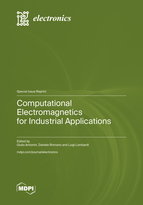Computational Electromagnetics for Industrial Applications
A special issue of Electronics (ISSN 2079-9292). This special issue belongs to the section "Microwave and Wireless Communications".
Deadline for manuscript submissions: closed (31 December 2021) | Viewed by 18427
Special Issue Editors
Interests: computational electromagnetic; electromagnetic compatibility (EMC) analysis
Interests: computational electromagnetics
Interests: computational electromagnetics
Special Issue Information
Dear Colleagues,
At present, computational electromagnetics (CEMs) methods play an important role in rapid modeling and design of electromagnetic (EM) systems and their industrial applications. Virtual prototyping based on computational electromagnetics is currently widely adopted in electrical and electronic systems design because of the high accuracy guaranteed by many numerical methods for the solution of Maxwell’s equations in a wide range of frequency from DC to hundreds of GHz or even in the THz range. With the continuous increase of integration and complexity in integrated circuits, electromagnetic compatibility (EMC) and signal integrity (SI) issues have consequently become very important. Hence, numerical modeling and simulation play a key role in the design of electromagnetic systems, and new algorithms and computational capabilities are increasingly essential to tackle EMC and SI issues. In this perspective, fast algorithms to allow an accurate and efficient analysis of complex EM problems are strongly requested. Additionally, semi-analytical methods can offer elegant and accurate solutions to complex EM problems.
Furthermore, active devices are often affected by heat conduction, potentially leading to electrothermal breakdown. Under such circumstances, predictive simulations must rely on multiphysics computational approaches as opposed to electromagnetics‐only methods. Parallel computing can offer new potential to consolidated methods.
Real-life applications are typically complex and their electromagnetic models electrically large. This calls for accurate wideband model order reduction/macromodeling techniques that make their simulation feasible. Furthermore, in the optimization of large platforms (aircrafts, automotive), design parameters are very likely affected by uncertainty that needs to be taken into account through accurate and efficient uncertainty quantification techniques.
The objective of this Special Issue is to present studies in the field of computational electromagnetics for the analysis of industrial applications and report recent important findings and developments of advanced solution methods for modeling complex EM problems.
Topics of interest for publication include but are not limited to:
- Numerical methods for Maxwell’s equations (FDTD, FEM, FVTD, MoM, PEEC, TLM);
- Wideband solutions of Maxwell’s equations (from DC to daylight);
- Fast algorithms to speed up EM methods;
- Semi-analytical methods;
- Multiphysics methods;
- Multiscale problems;
- Parallel computation;
- Model order reduction methods;
- Macromodeling techniques;
- Uncertainty quantification.
Prof. Dr. Giulio Antonini
Dr. Daniele Romano
Dr. Luigi Lombardi
Guest Editors
Manuscript Submission Information
Manuscripts should be submitted online at www.mdpi.com by registering and logging in to this website. Once you are registered, click here to go to the submission form. Manuscripts can be submitted until the deadline. All submissions that pass pre-check are peer-reviewed. Accepted papers will be published continuously in the journal (as soon as accepted) and will be listed together on the special issue website. Research articles, review articles as well as short communications are invited. For planned papers, a title and short abstract (about 100 words) can be sent to the Editorial Office for announcement on this website.
Submitted manuscripts should not have been published previously, nor be under consideration for publication elsewhere (except conference proceedings papers). All manuscripts are thoroughly refereed through a single-blind peer-review process. A guide for authors and other relevant information for submission of manuscripts is available on the Instructions for Authors page. Electronics is an international peer-reviewed open access semimonthly journal published by MDPI.
Please visit the Instructions for Authors page before submitting a manuscript. The Article Processing Charge (APC) for publication in this open access journal is 2400 CHF (Swiss Francs). Submitted papers should be well formatted and use good English. Authors may use MDPI's English editing service prior to publication or during author revisions.








